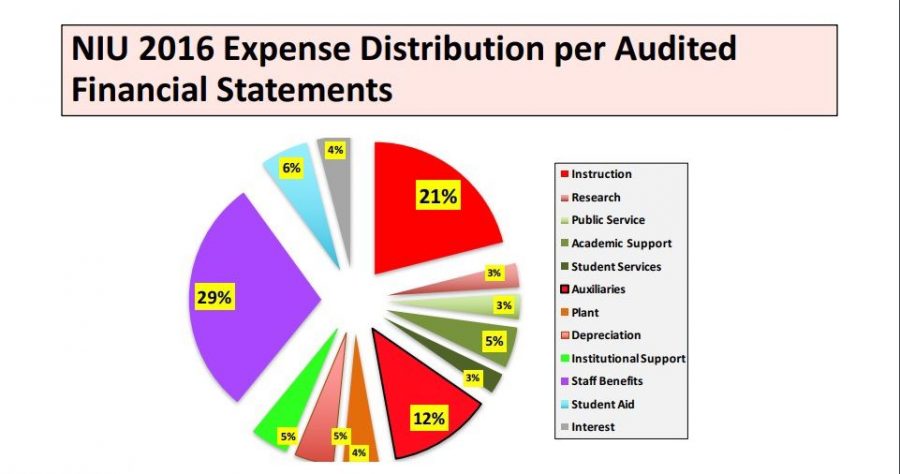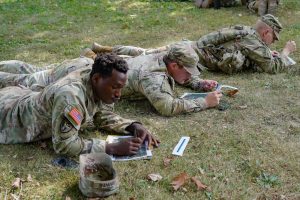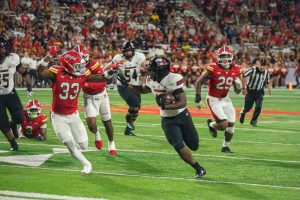21 percent of NIU funds spent on classes
Above is a percentage breakdown of NIU’s expense distribution per audited financial statements of 2016. The information was presented Thursday by Howard Bunsis, former chair of the American Association of University Professors Collective Bargaining Congress.
October 16, 2017
DeKALB — Of the $48.3 million NIU received during the 2016-2017 academic year, 21 percent went toward instruction, making for just one of multiple “surprising” facts presented Thursday in hopes of rallying the United Faculty Alliance.
Howard Bunsis, accounting professor at Eastern Michigan University and former chair of the American Association of University Professors Collective Bargaining Congress, delivered a presentation to members of the tenured and tenure-track faculty union that covered several aspects of the university’s finances and spending.
Bunsis said the goal of his presentation was to inform union members about the university’s financial state as they go through the process of contract negotiations.
Bunsis collected data for the presentation from university’s 2016 audited financial statements.
“He can do a detailed analysis of NIU finances, but also can compare it to comparable institutions,” said Virginia Naples, biology professor and president of the United Faculty Alliance. “And he was doing the [Mid-American Conference], as the group of other universities that are closest to us in terms of size and mission and things of that nature.”
State appropriation
NIU received its first full state appropriation in Fiscal Year 2018 after a nearly three-year budget impasse. The university has been recovering financially from this gap in appropriations, and as a result, funding has been coming from other areas of revenue.
“The university is about a $5- to 600 million a year organization,” Bunsis said. “You take $50 million away that you’re used to getting, it’s going to hurt.”
Bunsis said while the lack of a state budget was substandard, it didn’t fully deplete the university’s reserve fund of more than $100 million.
“You guys may have gotten the impression that we have no money, everything is gone, zero, nothing left,” Bunsis said. “Well that didn’t happen — yes, [it was] bad but not debilitating.”
As a result of the budget impasse, university community members were often reminded of the financial crisis, yet Bunsis said the impasse wasn’t entirely responsible for NIU’s financial woes.
“ ‘The state’s broke; the state has no money; we’re poor;’ that’s what you’ve been hearing for how long?” Bunsis said. “Several years. So we’re just going to attack it head on. I think those are the simplistic conclusions.”
Funding prioritization
Faculty members voiced concerns during the presentation regarding the prioritization of funding and where the university is concentrating the majority of its funds.
“Even though I knew a lot of the numbers before, I had no idea that only 21 percent of the money goes to instruction,” said Reva Freedman, associate professor of computer science and Unite Faculty Alliance treasurer. “All the money they bring in, and only 21 percent of it is going to the classroom; that’s really surprising.”
The hiring of faculty members has also slowed at the university; total full-time employees have dropped from 1,035 in 2013 to 936 as of this year, Bunsis said.
Freedman said department leaders have to receive approval from the provost to fill positions of those who have left or retired from the computer science department — something she said is difficult to attain.
To compensate for the lack of instructors, some programs have needed to increase class sizes.
Freedman said she used to have 20 to 30 students in a class, but now she has about 80 students in a class.
Naples said this has also resulted in classes no longer being offered that were once in the course catalog, which affects some students’ track to graduating because they cannot fill their schedules with the courses they need.
Despite this decrease in academic resources, athletics expenses have increased from $15 million in 2005 to $28 million in 2016, Bunsis said.
“Athletics is enjoyable; it does inspire teamwork and physical condition and a variety of good things, but that isn’t the primary reason students come to NIU,” Naples said.
Enrollment is down for the university, and Bunsis said NIU’s focus on sports isn’t doing enough to bring it back up. The revenue and expenses for Huskie athletics have both increased but revenues being made from sports are not enough to fill the growing deficit that has been increasing since 2014.
“They’re not increasing academic offerings, they’re not really supporting academic programs, they’re not highlighting the academic programs, they’re highlighting sports,” Bunsis said.
In 2016, the deficit was just under $20 million. This excess in expenditure is a result of the increasing expenses of athletics while the revenue has not increased at a fast enough rate.
“There is no doubt in my mind that tuition is higher than it should be and compensation to the staff is lower than it should be because of athletics,” Bunsis said.
Faculty salaries
Of the 12 universities that comprise the MAC, Bunsis said NIU was ranked 10th in full-time faculty salaries, 12th in associate salaries and 10th in assistant compensation during the 2016 – 2017 academic year.
Of the approximated $100 million in reserves, none of the unrestricted funds are going to faculty compensation.
“We have excellent people,” Naples said. “They are hard working. They’re dedicated. They care about their students. They excel in their disciplines. But when they get better offers elsewhere, you can’t blame them for wanting to go and have more reward financially for doing what they do.”
Bunsis calculated a cost of $520,337 if officials provided all faculty members with a 1 percent raise.
Bunsis also said the top 20 administrators received an average raise of 2.4 percent from 2016 to 2017 in comparison to the tenured and tenure track faculty members receiving nothing.
Freedman said administrators are necessary for the university to run, but she does not understand why their salaries are continuously increasing and worries that too much of the funding is going to higher administration.
“The thing that bothers me most is the fact that every year, the percent that the top administrators are getting is going up because they’re already over $200,000 a year and they’re getting annual raises,” Freedman said.
In addition to higher wage increases for administrative positions, coaching salaries have been increasing at a rate much faster than instruction salaries. In 2016, coaching staff received $7,471,149 compared to the collective $6,615,421 paid in 2014.
Naples said she feels undervalued as a professor and finds herself in “a debt situation” at the end of summer because of salary compression and inversion.
“I would like to see every person do as much as they can to become as well educated as possible so that they can understand what needs to be done and work toward achieving those goals,” Naples said. “I want everyone to become activated, and this kind of presentation is excellent because it gives people tools to use to try to understand the present situation.”
Spokesperson Joe King declined to comment on the data Bunsis presented.







